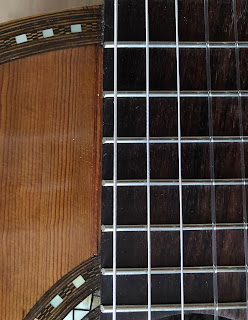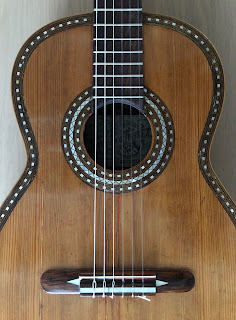donderdag 6 oktober 2022
Salvador Ibanez Concert Model 1905 - 1910
zaterdag 1 oktober 2022
Salvador Ibanez Around 1900 (Small bodied)
Salvador Ibáñez (1854-1920) was a Spanish
luthier. He made guitars, ukuleles, mandolins
and other stringed instruments. These
instruments were considered the finest of
their age and are prized for their excellent
quality and impeccable workmanship.
apprentice in guitar construction at Calle Muela
Valencia. In 1870 he started his own company:
Salvador Ibáñez y Albiñara.
Working in his shop were the ten-year-old
José Ibáñez and Magdalena Albiñara y
Magraner, from Ollería, Valencia.
Calle Ruzafa Valencia and from 1898 to 1906
his shop was located at Calle Bajada de San
Francisco. Salvador Ibáñez made bandurrias,
lutes, six and nine-string guitars and also
guitars with detachable necks. In 1897 he
made the world's first double-necked guitar.
(Salvador Ibáñez and Sons) were located at
Calle Bajada de San Francisco and at Calle
Padre Rico Valencia. When he died in 1920
his workshop continued to be managed by
his two sons until it was completely destroyed
during the Spanish Civil War (1936-1939)
in a bloody street fight, which cost the lives
of many of the personnel.
This was THE story up until now, however one of
my friends visited Madrid in order to meet some
colletors there and it became clear that at least one
of the sons of Salvador Ibanez didn't die in the civil
war and that the factory and its' machines were sold
to Telesforo Julve. A picture of a graveyard stone
from one of the sons from S. Ibanez attests:
DON SALVADOR IBANEZ SALABERT
DIED 21 abril 1967
A LOS 80 ANOS
R.I.P.
guitars not being available (and very much
sought after due to their excellent quality),
the Japanese distributor Hoshino Gakki
decided to start making Ibáñez guitars of
their own after years of importing Salvador
Ibáñez guitars to Japan. They purchased
the trademark and started production, first
naming the guitars "Ibanez Salvador" and
later Ibanez which obtained great success
in the 1970s and 1980s.
acoustic and electric guitars using the Ibanez
brandname and is oriented at all kinds of
devices for electric guitars and basses.
guitar. Eric Clapton has owned several original
Salvador Ibáñez guitars, one of which was sold
at a benefit auction in 1999 at Christies,
obtaining a final price of $42,000 USD.
The guitar was estimated between 3000 and
5000 USD what can be considered a fair
price on an auction. Regarding history it is
curious to discover that the first quality guitar
played by Francisco Tarrega was a Salvador
Ibanez before he switched to the Torres
guitar. A picture of Tarrega with a Salvador
Ibanez guitar seems to be around somewhere...
This guitar literally came in parts but as often happens the
so called cracks in the sound board were no more than the
seams of the parts the guitar was showing. Bigger problem
was the edge lining as that was existing of multiple layers
less than half a millimeter in width,
The label can be dated around 1900. Luckily other investigators
have found this information sometimes even by frequently visiting
Valencia and surroundings.
The typical placing of the individual blocks to support the
soundboard can be studied here as is the fan bracing that
only exist of three small bars. Only two transverse bars on
the soundboard. In the bigger models a double transverse
bar is placed above the sound hole thus preventing cracks
alongside the fingerboard after some time.
Under Construction
Dear interested readers I'm planning to make a bit of a historical overview about the (Salvador) Ibanez guitars that reached me alo...
-
Salvador Ibanez e Hijos (appr. 1910) This is another, somewhat later Salvador Ibanez guitar. It is an easy conclusion as the label states: S...
-
The way it was presented in the auction House. The tuners were in a terrible scondition but I succeeded in saving them and added 3 newly ...
-
This guitar wasn't in a bad condition apart from a loose back ...











































































